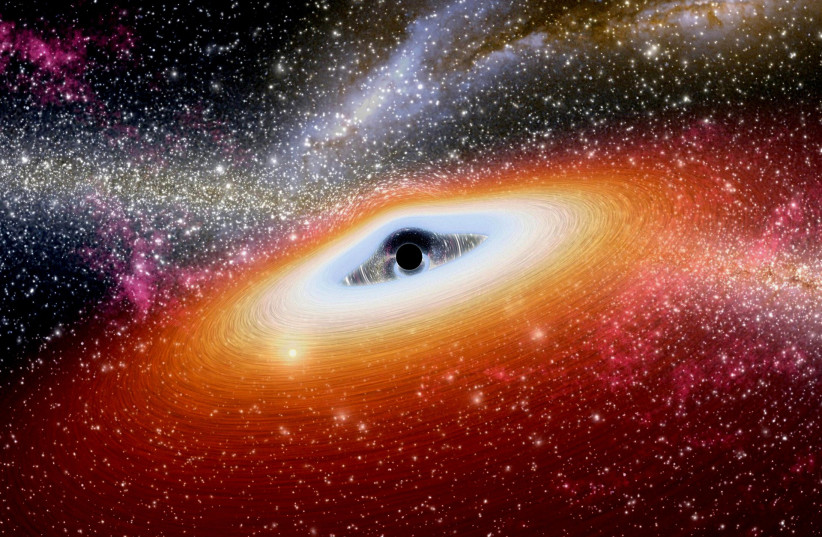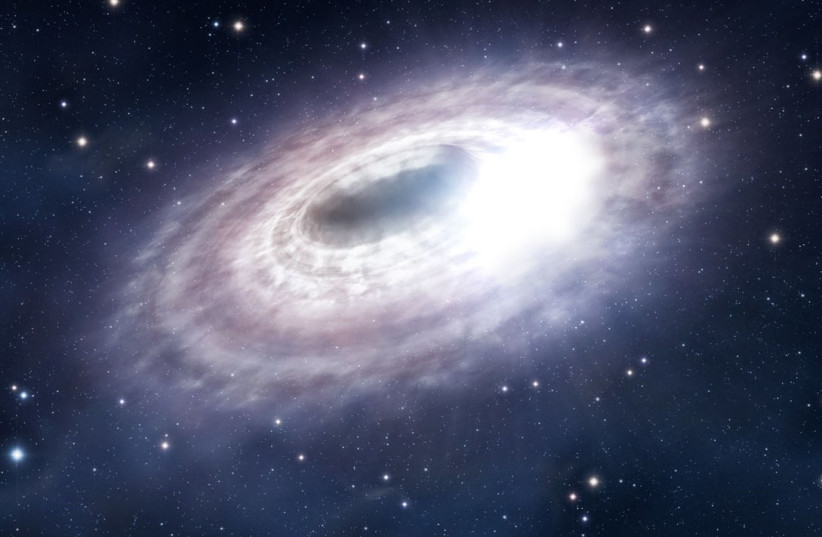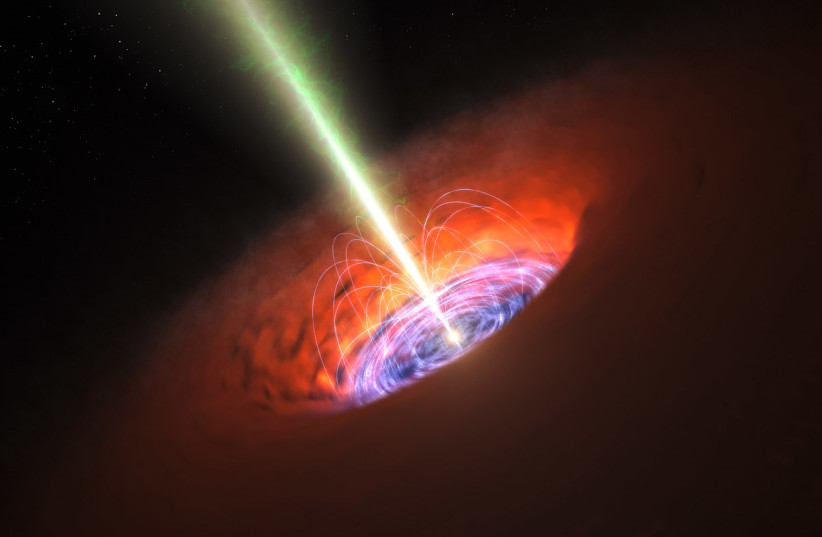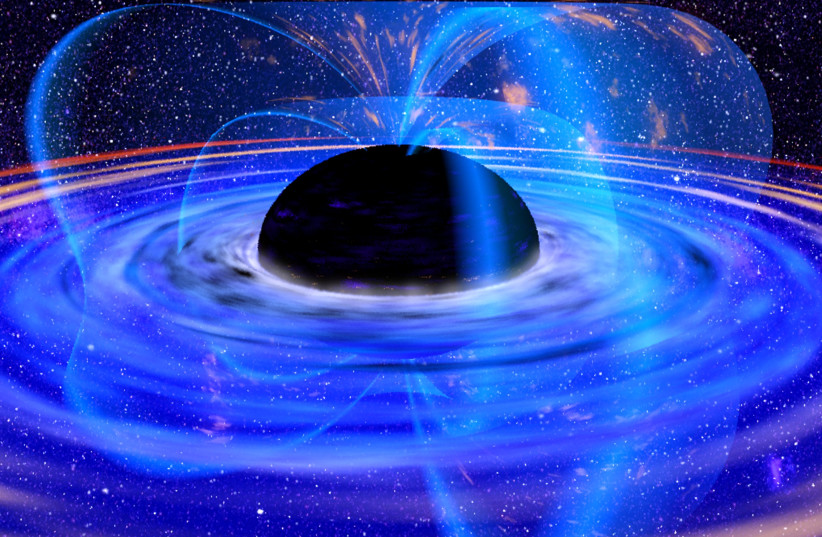There are 40 quadrillion black holes in the observable universe - study
Black holes have taken up around 1% of all ordinary (as in baryonic) matter in the universe.
By AARON REICH, Jerusalem Post, JANUARY 19, 2022

A supermassive black hole is seen in the center of a galaxy (illustrative). (photo credit: PIXABAY)
Black holes
are one of the most mysterious and terrifying phenomena to populate the
universe, and according to a new study, there may be far more of them
than we realize: A total of 40 quadrillion (40,000,000,000,000,000).
The findings come in the first study of a series published in the peer-reviewed academic periodical The Astrophysical Journal,
which focuses on modeling the mass function of black holes of various
sizes, ranging from stellar all the way to supermassive.
How many black holes are there in the universe?
That's a difficult question and likely cannot be answered any time
soon. But that is not the case with the observable universe, a vast
expanse of space that has a diameter of approximately 90 billion
light-years that represents the furthest extent of what in the universe
that can be seen by us on Earth with all the telescopes, space probes
and other methods of observation currently at our disposal.
So how many black holes are there in the observable universe?
According to the calculations of this study, that's 40 quadrillion, also known in scientific notation as 40 x 10^18.

Artistic impression of a material disc with illuminated gas around
Sagittarius A*, the supermassive black hole in the center of the Milky
Way. (credit: Wikimedia Commons )
But that's not all.
All these black holes gather a lot of matter into them through accretion. But just how much matter is that?
According
to the study, black holes have taken up around 1% of all ordinary
matter. This specifically refers to baryonic matter, which would
describe most things encountered in everyday life. Non-baryonic matter
refers to things like free electrons, neutrinos and, most notably, black
holes.
How do we know how many black holes exist?
In short, scientists did the math.
In
order to determine the number of black holes in the observable universe
and how much matter they have taken in, the researchers developed a new
method of calculation. This was done by evaluating a number of factors
like rate of star formation, the amount of stellar mass and metallicity -
the abundance of metals, which, in astronomy, refers to any element
heavier than hydrogen and helium.

Artist impression of a supermassive black hole at the center of a galaxy. (credit: Wikimedia Commons)
It further relied on the use of a stellar and binary evolution code
to further calculate the evolution of stars. This evolution code is
combined with data and information about star formation and the
enrichment and distribution of metals in individual galaxies.
Then, it was all put into a model alongside the use of necessary equations.
It's
complicated, to say the least. But it is also innovative; a robust and
revolutionary "computation of the stellar black hole mass function
across cosmic history," lead author PhD student Alex Sicilia at the
International School for Advanced Studies (SISSA) in Italy noted in a statement.
And its complexity is only further heightened by how multidisciplinary it is. As noted by Sicilia's supervisor Prof. Andrea Lapi, it required expertise in galaxy formation and evolution, gravitational waves, stellar astrophysics and more.
What are black holes?
Black
holes are, to put it simply, massive concentrations of gravity that are
so strong, nothing, not even light, can escape them. As such, it can be
very hard to spot them. In fact, scientists weren't even sure they
existed 20-30 years ago. The only way we know black holes exist is
because they have an enormous gravitational pull that influences
surrounding matter. In other words, it can be hard to see a black hole,
but we can see it affecting everything around it.


An artist's impression of a black hole accretion disk. (credit: Wikimedia Commons)
Most
black holes are formed when a star dies, its core collapsing in on
itself to form one massive concentration of gravity. They continue to
accrete matter over time and, while light and matter can't escape,
radiation and radio waves do get emitted.
Today,
our scientific understanding of black holes as grown considerably, and
we now know a lot more about them. For example, supermassive black holes
– which, as their name implies, are absolutely enormous – can be
located at the centers of most major spiral galaxies. Our own Milky Way
galaxy is no exception, with the supermassive black hole Sagittarius A* being located in the galactic center.
The recent study may have also shed light on another intergalactic mystery: The origin of supermassive black holes.
How are supermassive black holes created?
While the origins of most black holes are known, how supermassive black holes are created is a lot more unclear.
It
is thought that black holes gather material rapidly from the
surrounding environment and are surrounded by what is known as an
"accretion disk." These disks consist of fast-rotating high-temperature
gases that give off light - though the black holes themselves do not.
However, it is unclear if this is true, and our understanding of this process may be very much incomplete.
This
is something many scientists, including an international research team
led by the University of Haifa utilizing NASA's Hubble Space Telescope,
are trying to answer.
But this study presents a theory.
To
put it simply, supermassive black holes are thought to form with a
seed, which has been hypothesized to be formed when galaxies that birth
stars and experience supernovae see gases migrate inward to the galactic
center which will, eventually, fully condense and merge until a
supermassive black hole seed is formed. It is then that the black hole
grows bigger through accretion.
That
much was already known, but what the researchers figured out was about
seed distribution. Light seeds are distributed throughout the universe,
but how do they become heavier? That seems to be through the mergers of
star clusters and collapses, which would form heavier seeds. These
heavier seeds in turn are what are used to grow these supermassive black
holes.
Right now,
this is very much theoretical, but it is something the team is keen to
focus on next in an upcoming study. But it brings us another step closer
to understanding the mysteries of black holes and how they influence
and impact the universe around them.
Please recommend this page & follow the Sputniks Orbit


No comments:
Post a Comment